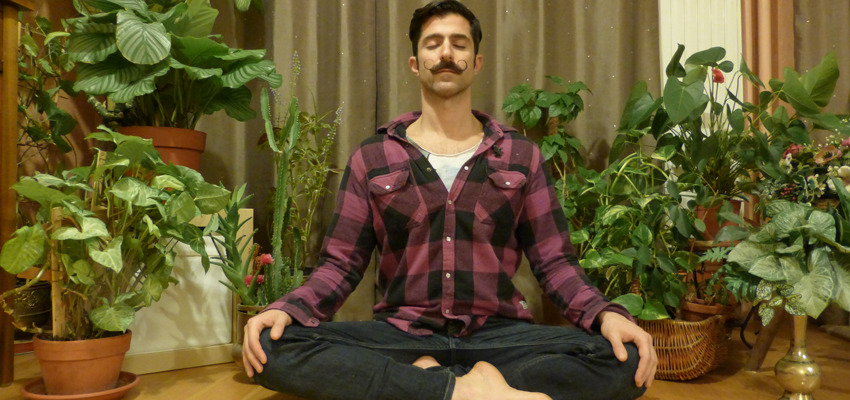
You May Also Enjoy
Just as we wish to remove toxins from our food, peace of mind requires removal of toxic people from our daily experience. Absorbing repeated doses of negativity counters your efforts towards personal Read
Congratulations! You want to meditate, but you’re not sure what to do. If you’re one who can’t handle too much esoteric sweetener in your spiritual coffee, here's a great guide to starting up a meditation practice from scratch.
The benefits of meditation can be easily outmatched by the frustration of actually trying to meditate. Ever try to bathe an excited puppy? Not easy. It doesn’t matter how your dog got downward or dirty. Let’s make the practice of meditation more accessible so you can actually enjoy it.
1. Set a clear intention.
Do you really want this? If the answer is yes, f**ing commit.
2. Eliminate excuses.
Wipe away eye-crusties. Blow your nose. Turn off the technology. Apply lip-balm. Go to the bathroom.
3. Find a comfortable seated position.
This could be in a chair or cross-legged on the floor, hips permitting. Rest your hands on the knees. The active word here iscomfortable…
4. ... But not TOO comfortable.
The point is to focus awareness, not shut it down. Constantly falling asleep is an indication that you need more rest in general. It could also mean you should sit up while you meditate, lazybones.
5. Keep a tall spine.
Inhale, roll the shoulders up to your ears. Exhale, roll them bad boys back and down. This stacks the head atop your neck while floating the shoulders over hips. Consider this a neutral, tall spine.
Every time you feel yourself hunching forward or slumping, reset your spinal situation with this inhale/exhale rolling shoulder magic.
6. Gently close the eyes.
Duh.
7. Maintain a simple breath.
No rush or pause. You can start out with a few full yogic Breaths. For meditation, nasal breathing makes it easier find a smooth, even pace. If you need to sigh once in a while, go for it. You will not be docked points.
ALL YOU NEED TO DO IS FOLLOW THE BREATH IN AND OUT.
Focus on the area between your nostrils and your upper lip. Observe the sensation of the air entering and exiting your body as it passes over this spot. Let this be your default.
It may seem easy, but the mind often wanders in pursuit of everything else. When you realize awareness has drifted, gently guide it back to the breath.
8. Give it time.
There are days when closing my eyes is like flipping over an old log. Thought bugs scatter and burrow deep into the pulp of my brain. For these first few moments, I'm just trying to stay calm while my mind finds equilibrium.
9. Observe without judgment.
The difference between observation and judgment is the attachment of meaning. Don’t try to dissect the WHY, HOW, or WHERE. What happens when you chase rabbits? You'll end up barreling down rabbit holes every time.
10. Don’t go to your thoughts. Let them come to you.
When they arrive, avoid holding on. Meditation is like playing a game of chicken with your mind. Try not to react when the crazies knock you down. Just calmly refocus back on awareness of breath.
11. Shift happens.
Distractions create discomfort, which causes frustration, which triggers feelings of failure. This is a common pitfall. Observe the reaction (HULK SMASH!!!) and pattern your response (just breathe). There is no fault, only blame. Give yourself credit instead.
12. Move if you must—just not too much.
Not everyone who meditates is a serene-faced monk glowing in the light of eternal peace. Legs fall asleep. Itches fire up. Shoulders slump. It takes time to sit comfortably for extended periods of time.
To that point...
Start small.
Seriously, five minutes a day is a great start. You’ll feel better adding on than taking away.
Take your time!
It’s easy to rocket off once the alarm sounds. Don’t jet off to the next appointment. Slowly unwind yourself. Take some deep breaths. Stretch out.
Remember, this should not be torture.
If you need to stop because you’re just not feeling it, follow that intuition. Cultivating meditative sensitivity includes listening to your truth, especially if that truth is “not right now, OK?”
What are the best meditation practices that work for you? Share them in the comments below!
You May Also Enjoy
The pace of our culture is increasing at an astonishing rate. While this speed certainly has its benefits and conveniences for our outer lives, they come at a great cost to our inner world. Read
To learn more about meditation or happiness, check out our video courses The Essential Guide To Meditation With Charlie Knoles and How To Create More Happiness & Meaning In Your Life With Charlie Knoles.
About the Author
Daniel Scott is yogi provocateur offering a fresh alternative to the traditional “yoga voice”. His classes are a lively mix of balance and improv, strength and flexibility, breath and body. With light heart and open mind, Daniel focuses on moving into postures, not through them. A globally renowned ashtanga-vinyasa teacher and Certified Level 2 AcroYoga instructor, Daniel enjoys barefoot running, street art, good coffee, large quantities, and great qualities. Deeply dedicated to sharing in the immense journey from self-conscious to self-aware, Daniel Scott strives to answer the ever-present question: Are you moving, or being moved?

Get daily wellness inspiration straight to your inbox!



No comments:
Post a Comment
Note: Only a member of this blog may post a comment.